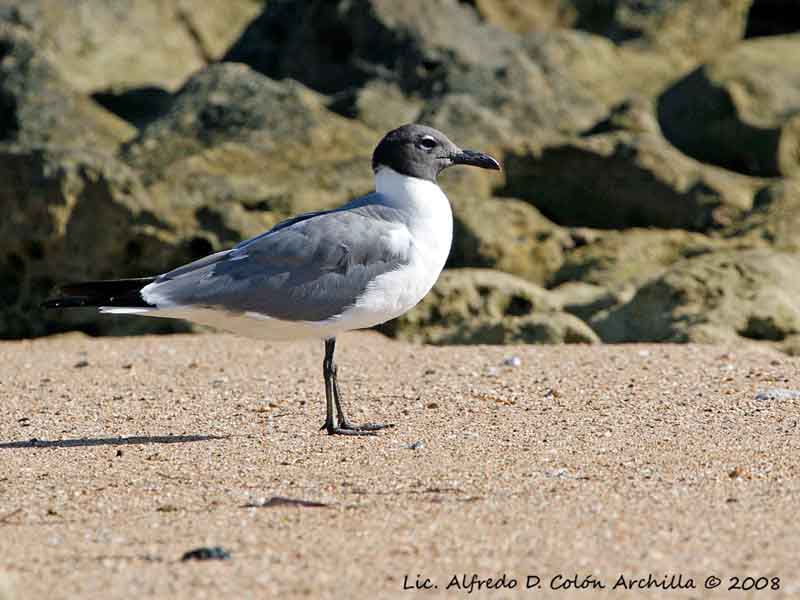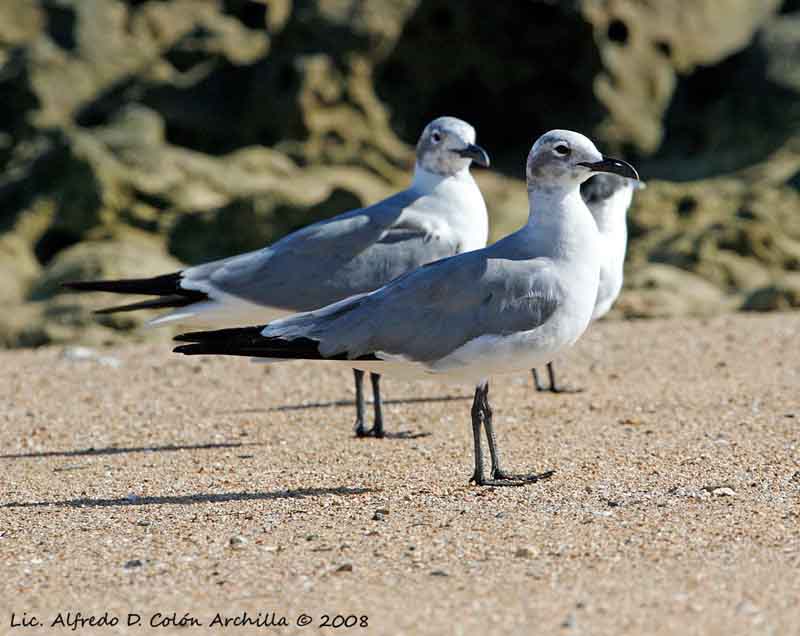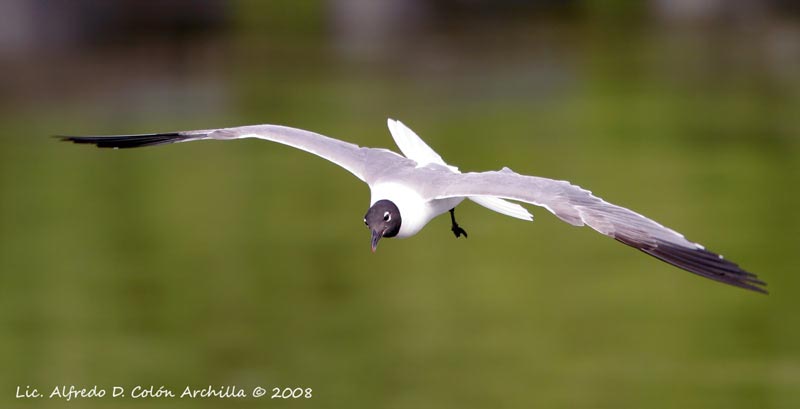
Laughing Gull
Leucophaeus atricilla
Charadriiforme Order – Laridae Family
BIOMETRICS:
Length: 36-41 cm ; Wingspan: 98-110 cm ; Weight: 275 g
DESCRIPTION:
Laughing Gull in breeding plumage has black head, black legs and feet, and red bill. Neck and underwing, belly and tail are white. Upperwing is dark grey with black tips.

In winter plumage, head becomes white and bill is black.
Young are mottled brown, belly is white, and bill, end of wings, legs, feet and tail are black. The 1st winter has dark grey back, and head and neck become white. The 2nd winter has white and dark plumage on head and neck, and tail is white.

VOICE: SOUNDS BY XENO-CANTO
Laughing Gull is a noisy bird. Its usual call is similar to a human high-pitched laughing "ha-ha-ha-ha-haah-haah-haah-ha-ha-ha". Other calls, shorter, also form part of its repertoire.
HABITAT:
Laughing Gull is almost only found on coastal areas, and rarely inland. On coasts, it often settles on beaches and close to salt-water marshes.
RANGE:
It is a North American species, vagrant in Europe (often in the United Kingdom). It lives in Atlantic coast of the United States. We see it in northern part in summer, but it may be found in south and south-east regions all year round.
BEHAVIOUR:
Laughing Gull feeds by walking on the beach where it pursues crabs, but also by dabbling into the mud, by swimming, sometimes by diving, or by pecking at the surface while flying.

It can also harass other birds to make them release their prey which it catches. It steals the Brown Pelicans’ food in a rather original way: it goes down on their head, and steals the fish directly in their pouch. It also feeds on insects caught on the wing.
It is partially migratory; the most part of the population is resident in its range. Laughing Gull often rests in large flocks, with other gulls’ species.
They may be found inland in small groups, along large rivers, but never go away from coasts.
FLIGHT:
Laughing Gull is a very nimble bird in flight, often qualified of "trapeze artist"! It flies level with the water to feed by pecking at the surface.

REPRODUCTION:
Laughing Gull reaches its sexual maturity at two years. Breeding season starts in early April and may last until July.
Laughing Gulls nest in large colonies. The nest is usually in coastal areas, on the ground or among grasses on the beach. It is rather large and made with grass and plant matter.
Female lays 2 to 4 olive-brown eggs, mottled black. Incubation lasts about 21 to 23 days, shared by both parents. Young leave the nest a few days after hatching. Parents still raise them during about 35 days.

DIET:
Laughing Gull feeds on aquatic invertebrates, shellfish, refuse, insects, earth worms and fish. It sometimes steals other birds’ eggs and eats the nestlings.
PROTECTION/THREATS / STATUS:
Laughing Gull is threatened by destruction of its coastal habitat, and repeated aggression by Herring Gulls which steal its eggs and eat its chicks.
Fr: Mouette atricille
All : Aztekenmöwe
Esp : Gaviota Guanaguanare
Ital : Gabbiano sghignazzante
Nd : Lachmeeuw
Sd : Sotvingad mås
Photographs by Alfredo Colón
Puerto Rico Wildlife
Text by Nicole Bouglouan
Sources :
HANDBOOK OF THE BIRDS OF THE WORLD Volume 3 by Josep del Hoyo-Andrew Elliott-Jordi Sargatal - Lynx Edicions - ISBN : 8487334202
FIELD GUIDE TO THE BIRDS OF NORTH AMERICA - National Geographic Society - ISBN: 0792274512
All About Birds (Cornell Lab of Ornithology)
Welcome to WhoZoo (Jill Foley)